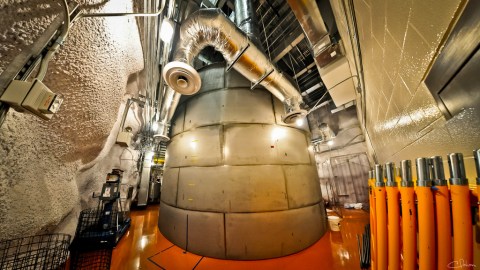The Secret to the Universe is at the Bottom of a Hole in South Dakota

As Neil deGrasse Tyson explains in “Dark Universe,” the Hayden Planetarium’s new space show at the American Museum of Natural History in New York, humans understand only 5% of the known universe. The stars, the planets, the intergalactic gases and other oddities like quasars and black holes only account for an insignificant amount of the total mass and energy of the universe. The rest is comprised of mysterious dark matter and dark energy, both of which we have only the faintest notion of what they actually are.
That’s why the current dark matter experiments taking place at the Large Underground Xenon (LUX) facility at the Sanford Underground Research Facility in South Dakota are so significant. At LUX, researchers are essentially taking vats of super-chilled liquid xenon, moving them to the bottom of an abandoned gold mine one mile under the surface of the earth and then hunting for evidence that bits of dark matter are bombarding the nuclei of these xenon atoms. If dark matter does, indeed, exist, researchers should be able to detect it when it collides into normal, everyday matter. For now, the detection instrumentation at LUX is not quite sensitive enough to pick up these reactions — something that recently led researchers to announce that they’ve found nothing yet in that gold mine.
A search for dark matter is nothing less than an attempt to divine the very nature of a substance so mysterious precisely because it can not be seen, touched, heard or smelled. You can’t even “trap” dark matter the way you can other particles. And yet, dark matter appears to account for 25% of the known universe. If the researchers are successful, it could mean the key to unlocking the secret of how the universe came to be what it is today. As Tyson explains in the “Dark Universe” show, what we do know is that a Big Bang occurred 13.8 billion years ago, setting off a chain of events that led to the creation of the modern universe. We are still mapping the cosmic background radiation left over from an explosion so violent that its gravitational effects are still being felt today.
For this story told by theoretical physicists to make sense, it means that we need to understand the essence of dark matter — it is the missing “mass” that ties together Einstein’s equations about mass and energy. One hypothesis is that space-time consists of vast intergalactic threads of this dark matter — an entity with mass but emitting no electromagnetic radiation — that is responsible for the types of gravitational effects that keep galaxies and stars spinning the way they do. While there is still considerable doubt and speculation as to what dark matter is, there’s no denying that our current understanding of the physical universe is incomplete without knowing about the missing 95% out there.
To think that all of this is possible by peering deep into a hole in South Dakota is remarkable. Just as the epic search for the Higgs boson became a celebrated validation of modern theoretical physics, the search for dark matter is also a celebration of how humans are able to grasp and understand the unseen world around us by developing a more sophisticated understanding of theoretical physics. The search for dark matter may bring us tantalizingly closer to understanding not just how the universe came to be, but how our modern lives came to be influenced by events that happened 13.8 billion years ago. It may turn out, that despite our protestations to the contrary, we’ve been living in the dark for the past 30,000 years of human creativity and knowledge.
image: LUX Underground Laboratory courtesy of C.H Faham for LUX Dark Matter on Flickr





